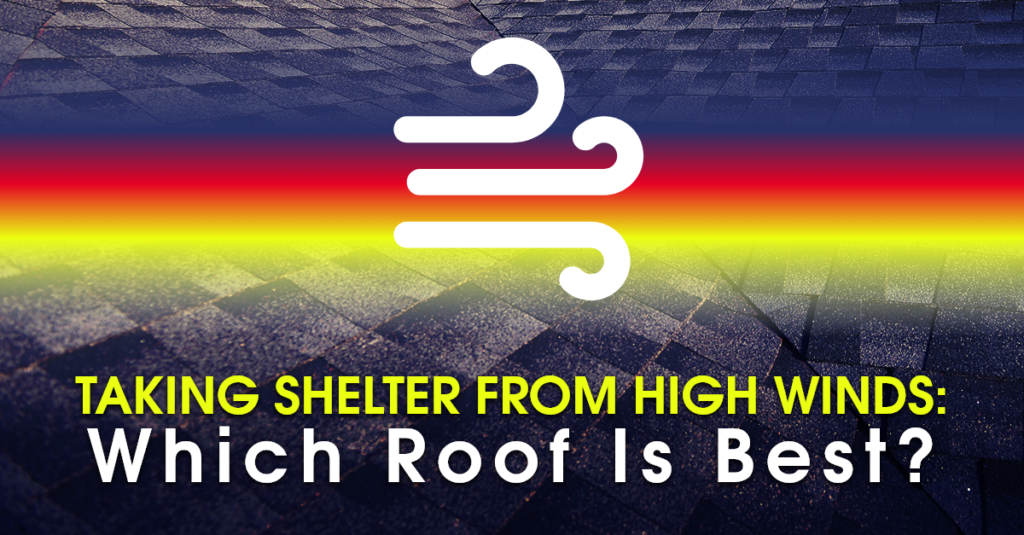Storms containing high winds can also bring heavy rain and hail. A roof that can withstand all of these climate conditions is the best protection for your home. Here, in the Jacksonville, Florida area, these types of storms are inevitable. Choosing a new roof solely on aesthetic appeal can be a costly mistake. Your roof must be as functional as it is aesthetic in order to withstand these events.
Here are several types of roofs that are specifically designed to handle high winds and the accompanying conditions without sacrificing curb appeal.
Metal Roofing
The ability to withstand winds up to 160 mph gives the metal the number one rating. Primarily used for commercial buildings, metal roofing has come a long way recently for residential homes. Design features are available to give a look at asphalt architectural shingles with the advantage of a long lifespan. This is more appealing to most homeowners. Excellent fire resistance is another quality of metal roofing. However, the cost of this material is a hindrancefor many homeowners. Several insurance companies offer discounts for installing metal roofing. In uncommon instances, hail may cause denting, but rarely can cause any structural damage. Certain styles are susceptible to moisture entering because of the exposed fasteners, but ultimately prove to be the best option against high winds for many homeowners.
The Advantages of Metal Roofing
- Ability to withstand 160 mph winds
- Long Lifespan
- Possible insurance discount
- Recently improved style
The Disadvantages of Metal Roofing
- The higher initial cost of installation
- Potential loss of curb appeal
- Exposed fasteners in certain styles
- May not be approved by homeowners associations
Clay and Concrete Tiles
Tile roofing is greatly resistant to high winds. The lifespan can be more than 50 years with regular maintenance. This is longer than most roofing materials, as clay tiles are heavier than even slate and prove more durable as well. The downside is pounding debris during a storm can cause cracking and chipping; however, installing storm collars adds strength and provides a barrier to stop dirt, leaves, and other debris from reaching roof tiles. Concrete tiles also provide the same high resistance to wind and are approximately the same weight. Clay and concrete tiles are both very popular in homes close to the coast where high winds and heat are a possibility.
Advantages of Clay and Concrete Tiles
- High wind resistance
- Aesthetic appeal
- Long lifespan
- Very strong when storm collar is added
Disadvantages of Clay and Concrete Tiles
- Cracking and chipping from debris
- Weight is more than other tiles
- Longer time to install
- Not applicable for certain roof slopes
Slate Tiles
The nickname for slate roof tile is “The forever roof.” This material can last an amazing one hundred years with little maintenance. The king of durability, Slate is an eco-friendly material and has a stiff construction which makes it resistant to surface damage from high winds. Despite the strong construction, the weight is not as heavy as concrete tiles. A very popular choice, slate also has an aesthetic appeal preferred by many homeowners. The initial cost is relatively high, but for anyone staying in their home for the long term, this is offset over time by the very long lifespan.
The Advantages of Slate
- Extremely long lifespan
- Very eco-friendly
- Low required maintenance
- Good resistance to fire
- Aesthetically pleasing
The Disadvantages of Slate
- Costly material
- Vulnerable to damage by debris and foot traffic
- Complicated installation process
- Requires strong structural support
Fiberglass Shingles
Fiberglass shingle roofing is the clearcut winner when it comes to cost. The Polymer material has an advanced construction capable of high strength and durability. There is high wind resistance and good fire protection. The disadvantage of fiberglass is reduced environmental protection as compared to metal roofing. Certain types of asphalt shingles offer wind resistance of 60 to 80 mph, but the 130 mph rating of fiberglass shingles meets the building code restrictions for most areas. The ease of replacing damaged shingles is also a plus.
The Advantages of Fiberglass Shingles
- Wide variety of colors and styles
- Affordable for most budgets
- Lets you keep the original look of your home
- Easy repairs by replacing individual shingles
The Disadvantages of Fiberglass Shingles
- Requires special tools for installation
- High cost although less than certain other roofing
- Less durability
- May allow mildew to form if not maintained correctly
These types of roofing can handle the climate conditions we have here in Florida. Choosing a new roof is a personal choice for homeowners, but these roof materials are good options to consider.
Still uncertain? StormForce Roofing has been proudly serving customers in Jacksonville and the surrounding area since 2011, establishing trust through top-notch customer service and quality work. Our certified staff will be happy to answer any questions regarding the right roof for your home. Contact StormForce Roofing today to discuss which roof replacement is best for you. We’re here to partner with you to provide a safe strong roof to protect you and your family!
